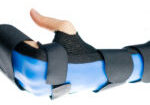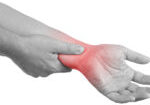Incorporating Emerging Evidence into Clinical Practice for Patients Experiencing Dorsal Wrist Pain During Weight-Bearing Activities
By: Brittany Day
Supporting Evidence
A randomized control study recently published in the Journal of Hand Therapy found rigid carpal stabilizing taping (CST) to significantly increase passive range of motion, active range of motion, and decrease pain in patients experiencing dorsal wrist pain during weight-bearing extension compared to placebo with elastic tape (Kim et al., 2019).
Rationale
Wrist extension takes place at the radiocarpal and midcarpal joint (2 degrees of radiocarpal motion to every 1 degree of midcarpal motion) and occurs as the proximal carpal row rolls dorsally while gliding volarly on the radius which may lead to gapping within the proximal carpal row during end-range movements (Foumani et al., 2009). When weight-bearing in extension, the scaphoid supinates while the lunate pronates effectively spreading the carpal bones further apart limiting extension potential (Kobayashi et al., 1997). The idea behind CST is to restrict the midcarpal joint, scaphoid supination, and lunate pronation to increase wrist extension potential with reduction in pain (Kim et al., 2019).
Who is Right for Carpal Stabilizing Taping?
CST may used for patients with dorsal wrist pain caused by various diagnoses such as:
- Distal Radius Physical Stress Injuries
- Scaphoid Impaction Syndrome
- Dorsal Impingement Syndrome
- Wrist Hypomobility without Ligament Instability
CST may not be appropriate for:
- Allergies to adhesives
- Tenosynovitis
- Dorsal Wrist Ganglion Cyst
- Scapholunate Injury or Instability
- Carpal Tunnel Syndrome
Dorsal impaction hand therapy – How to Apply Tape
- Use rigid athletic tape that is 1-2 cm in width.
- Use a marker to indicate four bony landmarks on the wrist: Dorsal ridge of scaphoid, listers tubercle, triquetrum, pisiform
- Connect the indicated marks with tape circumferentially while patient’s hand is resting at 45 degrees of flexion.

Carpal Stabilizing Taping Intervention Ideas (dorsal wrist impingement exercises)
The following is a list of interventions that may be completed with CST and are a progression from mild to moderate difficulty. Clinical reasoning must be used when progressing patient.
Ball Rolling – Place hand firmly on ball. Roll forward into flexion and back into extension without lifting hand. Complete exercise for 3 minutes.
Tray Balancing – Balance a tray or plate in palm. Hold without dropping for 3 minutes.

Wrist Extension with PowerWeb – Hold PowerWeb in lap or on a table. Press wrist into extension. Hold 10 seconds and repeat 10 times.

Wall Slides with Towel – Begin with towel in hand resting on wall. Shoulder should be flexed over 90 degrees. Slowly lower arm to increase demand on wrist extension. Sustain stretch for ten seconds just before the point of pain is reached. Repeat 10 times.

Wall Push-Ups– Place hands on wall with shoulders at 90 degrees and elbows extended. Complete 3 sets of 10 push-ups on the wall.

References:
Foumani, M., Strackee, S.D., Jonges, R., Blankevoort, L., Zwinderman, A.H., Carelsen, B., & Streekstra, G.J. (2009). In-vivo three-dimensional carpal bone kinematics during flexion–extension and radio–ulnar deviation of the wrist: Dynamic motion versus step-wise static wrist positions. Journal of Biomechanics, 42(16), 2664-2671.
Kim, G., Weon, J., Kim, M., Koh, E., & Jung, D. (2019). Effect of weight-bearing wrist movement with carpal-stabilizing taping on pain and range of motion in subjects with dorsal wrist pain: A randomized controlled trial. Journal of Hand Therapy, 33(1), 25-33.
Kobayashi, M., Berger, R., Nagy, L., Linscheid, R., Uchiyama, S., Ritt, M., & An, K. (1997). Normal kinematics of carpal bones: A three-dimensional analysis of carpal bone motion relative to the radius. Journal of Biomechanics, 30(8), 787-793.
3 Comments
Leave a Comment
More To Read
THE SENSITIVITY AND SPECIFICITY OF ULTRASOUND FOR THE DIAGNOSIS OF CARPAL TUNNEL SYNDROME: A META-ANALYSIS
Fowler, J. R., Gaughan J. P., & Ilyas, A.M. (2011). The sensitivity and specificity of ultrasound for the diagnosis of carpal tunnel syndrome: A meta-analysis. Clinical Orthopedics and Related Research, 469(4), 1089-1094. The Skinny –The authors sought out to determine the sensitivity and specificity of ultrasound therapy for the diagnosis of carpal tunnel syndrome using…
Read MoreFactors that influence orthosis adherence in patients with acute traumatic tendon injuries to the hand
Savaş, S., & Aydoğan, Ç. (2020). Factors affecting orthosis adherence after acute traumatic hand tendon repairs: A prospective cohort study. Journal of Hand Therapy, S0894113020301848. https://doi.org/10.1016/j.jht.2020.10.005 World Health Organization. (2003). Adherence to long-term therapies: evidence for action. World Health Organization. The Skinny Adherence to orthosis wear is vital for protecting healing tendons after a traumatic tendon…
Read MoreManagement of a TFCC Injury in Hand Therapy
By: Taylor Volentine The wrist is composed of very complex joints that assists with movement in individuals of all ages and abilities. For instance, an active individual who participates in sports such as tennis, football, or gymnastics may increase the probability for wrist complications and injury (Morrison, 2019). Individuals with repetitive trauma from work or…
Read MoreThe Importance of Purposeful Activities Following Surgical Repair of a Distal RadiusFracture
By: Kelsey Melton Collis, J. M., Mayland, E. C., Wright-St Clair, V., Rashid, U., Kayes, N., & Signal, N.(2022). An evaluation of wrist and forearm movement during purposeful activities andrange of movement exercises after surgical repair of a distal radius fracture: A randomizedcrossover study. Journal of Hand Therapy. https://doi.org/10.1016/j.jht.2022.07.009 The Skinny: This randomized crossover study…
Read MoreSign-up to Get Updates Straight to Your Inbox!
Sign up with us and we will send you regular blog posts on everything hand therapy, notices every time we upload new videos and tutorials, along with handout, protocols, and other useful information.







Is there a video on finding the bony prominences and application? How much pull (if any) is there to secure it?
It works
I have taped my wrists for years while lifting…Subsequently i have no hair on my wrists..
It limits, to some degree, the combined motion of supination and flexion helping to avoid a TFCC issue while bearing weight
Does this kind of issue/ pain flare up and disappear overnight? Or does it linger?